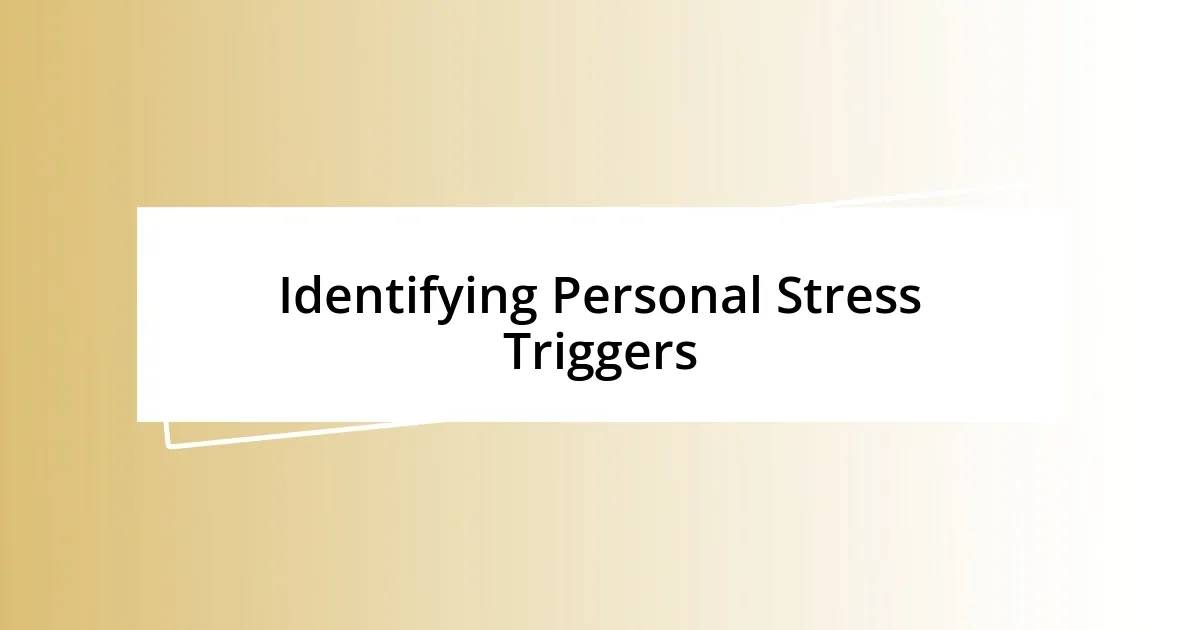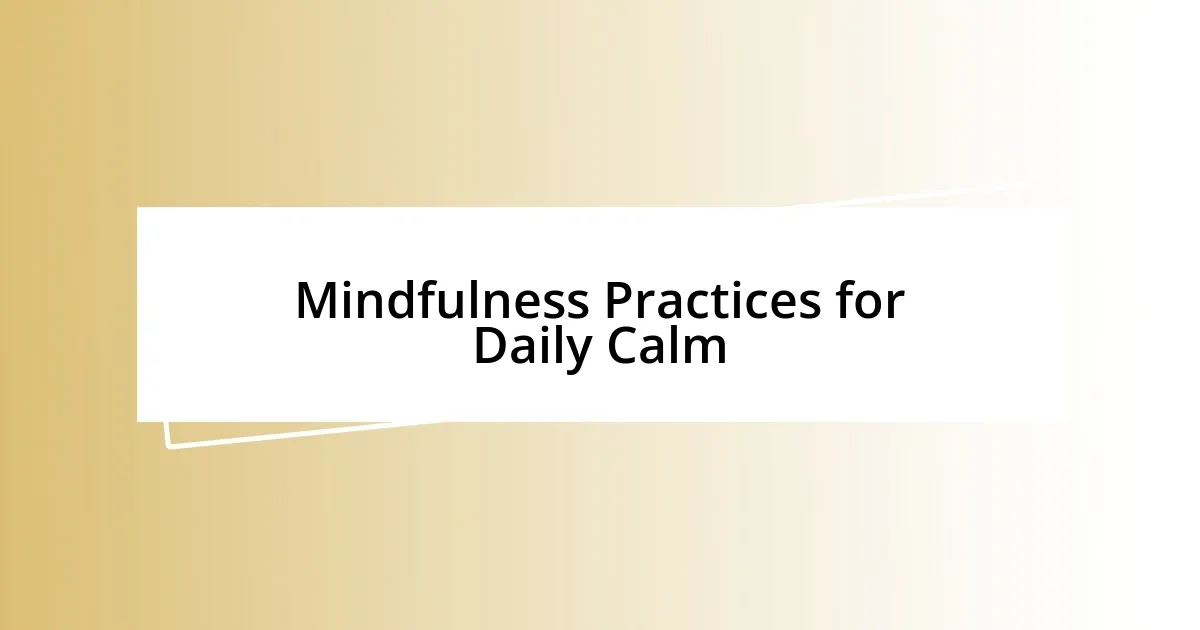Key takeaways:
- Stress manifests physically and emotionally, impacting mood and health; addressing it is crucial for well-being.
- Identifying personal stress triggers can help create tailored coping strategies for managing stress effectively.
- Breathing techniques, such as deep belly breathing and the 4-7-8 method, can significantly reduce stress and enhance focus.
- Creating a supportive environment, both physically and digitally, fosters better emotional health and resilience against stress.

Understanding Stress and Its Effects
Stress is an incredibly common experience, often manifesting as that tight feeling in your chest or that constant sense of being overwhelmed. I remember a time when I had so much on my plate that I actually felt like I was wearing a cloak of anxiety every single day. It’s intriguing to think: how often do we dismiss these feelings instead of confronting them?
The effects of stress can ripple through our lives, influencing everything from our mood to our physical health. For instance, during a particularly stressful work project, I found myself eating junk food and skipping sleep, which only compounded the anxiety I was already feeling. Isn’t it amazing how our emotional state can directly alter our behavior, often in ways that are counterproductive?
What I’ve learned is that stress doesn’t just disappear; it accumulates if we don’t take the time to address it. I once had a coworker who struggled with stress-related insomnia, and eventually, it impacted her performance at work. It raises a crucial question: how many of us have been there, sacrificing our well-being for a fleeting sense of accomplishment? Understanding the nature of stress and its effects on our daily lives is the first step toward finding effective ways to manage it.

Identifying Personal Stress Triggers
Identifying what triggers stress in our lives is critical for creating effective relief strategies. For me, stress often sneaks up during family gatherings, where the blend of expectations and dynamics can become overwhelming. It took me years to recognize that the pressure to keep everyone happy sparked anxiety that lingered long after the event. When we shine a light on these triggers, we can develop tailored coping mechanisms that truly resonate with our individual experiences.
Here are some common personal stress triggers to consider:
-
Time Constraints: I always feel the tension ramp up when deadlines loom, especially if I underestimate the time needed for tasks.
-
Personal Relationships: Conversations that lead to misunderstandings can leave me emotionally drained. I’ve learned to pause and communicate openly.
-
Financial Worries: I recall nights spent tossing and turning over bills, with each concern compounding my stress.
-
Workload: While I thrive under pressure, there comes a point where too many tasks can grind me down. Acknowledging when to say ‘no’ has been invaluable.
-
Change: Transitioning to new environments or roles can unsettle me. Embracing the discomfort as part of growth has eased some of that anxiety.
Recognizing these triggers allows for profound self-awareness. This understanding paves the way for healthier responses, ultimately leading to a more balanced life.

Effective Breathing Techniques for Relief
When it comes to stress relief, effective breathing techniques can be a game changer. I vividly remember a stressful moment before a public speaking engagement. My heart raced, and each breath felt shallow. Then, I remembered a technique I had learned: deep belly breathing. It’s like finding an anchor in a chaotic storm; it brings intentionality back into the chaos. Taking a moment to inhale deeply through my nose, expanding my abdomen, then slowly exhaling through my mouth, surprisingly calmed my nerves.
Another technique that I find particularly helpful is the 4-7-8 breathing method. This involves inhaling for four seconds, holding the breath for seven seconds, and then exhaling for eight seconds. It might feel a bit tricky at first, but once you get the hang of it, it serves as a natural sedative for the nervous system. I often use it during moments when I feel overwhelmed, and it’s astonishing how a few cycles of this can transform my state of mind.
Lastly, box breathing, popular among individuals in high-pressure environments, has also proven effective for me. With this method, I envision a box and breathe in through my nose for four seconds, hold it for four, breathe out for four, and finally hold again for four seconds. I was skeptical at first, but I quickly noticed how it sharpened my focus and provided clarity during hectic times. Breathing techniques like these aren’t just practical; they engage both mind and body, creating a connection that helps soothe stress.
| Breathing Technique | Description |
|---|---|
| Deep Belly Breathing | Inhale deeply through the nose, expanding the abdomen, then exhale through the mouth. Effective for calming nerves in stressful situations. |
| 4-7-8 Breathing | Inhale for 4 seconds, hold for 7 seconds, and exhale for 8 seconds. Acts as a natural sedative for the nervous system. |
| Box Breathing | Breathe in for 4 seconds, hold for 4 seconds, breathe out for 4 seconds, and hold again for 4 seconds. Enhances focus and provides clarity in hectic moments. |

Mindfulness Practices for Daily Calm
Mindfulness practices have become essential tools for my daily calm. One practice I enjoy is grounding—spending even just five minutes outdoors, feeling the grass beneath my feet, and focusing on the sounds around me. This simple act always shifts my perspective, bringing an instant sense of peace that helps recenter my thoughts. Have you ever noticed how nature can quietly whisper tranquility into a chaotic mind?
I also make it a habit to cultivate gratitude through journaling. Each morning, I jot down three things that make me feel thankful. Surprisingly, it sets a positive tone for my day. It’s almost like reframing my mindset; in those moments, stressors shrink in size, and I remember the things that truly matter. This practice not only clears mental clutter but also fosters a sense of connection to the present.
Another practice that resonates deeply with me is mindful eating. When I take the time to savor my meals without distractions, it transforms the experience into a ritual. I recall a particularly hectic week where I dedicated lunches to mindfulness—focusing on each bite, the flavors, and textures. Instead of simply fueling my body, I was nourishing my soul, something I didn’t realize I had been missing. Have you tried this approach? It’s incredible how slowing down can amplify my appreciation for the little joys in life.

Physical Activities to Reduce Stress
Physical activity has always been my go-to remedy for stress. I remember one particularly overwhelming week, where the weight of deadlines felt like a boulder on my shoulders. On a whim, I decided to go for a run. With each step, I felt that boulder slowly lifting away. The rhythm of my feet hitting the pavement and the rush of fresh air invigorated me, transforming anxiety into a sense of clarity and purpose. Have you ever felt that rush of relief after a good workout? It’s as if the world becomes lighter.
Yoga is another physical activity that I cherish. When I stumbled into my first yoga class, I was intrigued by the fluidity and grace that accompanied each pose. Initially, it was challenging to clear my mind and focus on my breath, but with practice, it became a sanctuary for my thoughts. Each session felt like an emotional reboot, as I stretched away tension and embraced the present moment. The feeling of grounding myself on the mat had a calming effect, leaving me filled with a sense of peace that lingered long after class.
Lastly, I cannot overlook the connection I feel during team sports. Joining a local soccer league was one of the best decisions I’ve made. The camaraderie and laughter with teammates provided a much-needed diversion from daily stressors. Remember that flurry of excitement during a crucial match? The adrenaline rush, the collective cheers, and even the friendly competition—it’s an electric reminder that we’re all in this together. Engaging in physical activities like these not only alleviates stress but also fosters connections that enrich our lives.

Creating a Supportive Environment
Creating a supportive environment has been a game-changer for me. I remember when I transformed my home workspace into a cozy nook filled with plants, soft lighting, and personal mementos. This simple change made a significant difference in my focus and mood. Isn’t it amazing how our surroundings can impact our emotional state?
I also cherish the moments spent with loved ones in a comfortable setting. Whether it’s sharing a homemade meal or engaging in deep conversations over coffee, these gatherings create a sense of warmth and belonging. It’s these interactions that remind me of the power of connection. Have you felt that surge of joy when surrounded by friends or family?
Another crucial aspect is curating my digital environment. I’ve become intentional about what I read and who I follow on social media. When I unfollowed accounts that promoted negativity, I noticed a remarkable difference in my mental clarity. It’s empowering to choose content that inspires and uplifts us. Have you ever taken a moment to evaluate how your online presence affects your emotions?












